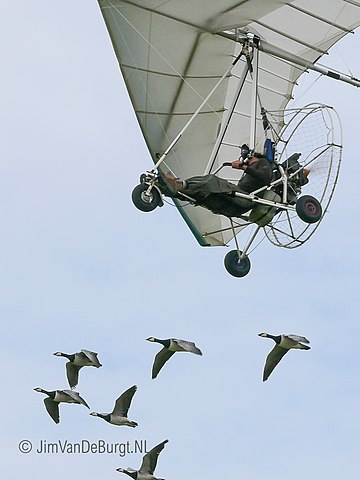
Soon after hatching, if baby ducklings see a cardboard box pulled by a string passing by, they'll follow the box as if it were their mother. Moreover, as the ducklings grow up, they continue following the box. They just do not catch on...
Ducklings as well as newly hatched geese, chickens and turkeys are born with the instinct to follow the first thing they see moving close to them. It's said that the moving cardboard box triggers the response of following the box. Then the newly hatched birds are imprinted on the box. This was first scientifically documented in the 1930s when in Austria Konrad Lorenz scientifically studied the imprinting process, and ultimately won a Nobel Prize. Lorenz's work is describe in a freely available online PBS story.
 Christian Moullec flying with geese in Leeuwarden, the Netherlands, in 2008; image courtesy of Jim van de Burgt, the Netherlands, and Wikimedia Commons
Christian Moullec flying with geese in Leeuwarden, the Netherlands, in 2008; image courtesy of Jim van de Burgt, the Netherlands, and Wikimedia CommonsBuilding on Lorenz's discoveries, Christian Moullec pioneered "flying with birds" in a microlight craft, shown at the right. Imprinting various bird species on himself as they hatched, then later flying with them, he "transformed himself into a bird to accompany protected species on their migratory routes." You may want to see a National Geographic video showing Christian Moullec flying with birds.
Christian Moullec imprints newly hatched birds on himself with positive results, but normally when wild animals imprint on humans, eventually it causes problems. The Wildlife Center of Virginia's web page on Human-imprinting in Birds tells us that human-imprinted birds grow up unable to appropriately interact with either humans or their own species. "Birds who are human-imprinted are deemed unsuitable for release back into the wild due to these inappropriate interactions," they write. When orphaned or injured baby birds are cared for, the center takes special care to prevent the bibies from imprinting on staff and volunteers. There's no talking to them, and sometimes special clothing is worn to hide human features.
It's easy to imagine how certain birds could have evolved in such a way that this strange situation could arise. In Nature, the first moving thing any newly hatched duckling or gosling sees is nearly always its mother. In a sense, Mother Nature found it "cost less evolutionary effort" to genetically program ducklings to follow the first moving thing passing by, than to have them born with such complex programming that at birth they'd automatically follow their mother, and not any other moving object around them.